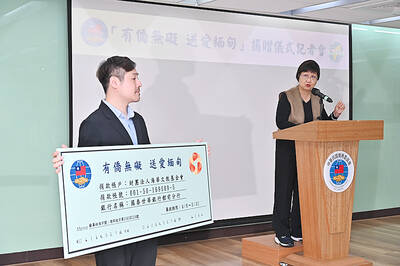A civic group urged the government yesterday to take action to dissuade children and teenagers from using mobile phones because of health concerns.
The Taiwan Electromagnetic Radiation Hazard Protection and Control Association (TEPCA) presented results of a survey on child and teenager cellphone use, along with information about the levels of electromagnetic radiation produced by cellphones marketed in Taiwan.
The survey, conducted last month and this month among children and teens aged six to 18, found that 34.4 percent of polled elementary school students, 67 percent of junior high school students and 89.6 percent of senior high school students used cellphones.
Based on the survey, the association, a non-governmental organization promoting legislation to restrict the impact of electromagnetic radiation on public health, estimated that around 2.2 million children and teenagers nationwide have their own mobile phones.
The survey also found that the older respondents talked longer on the phone, estimating that 390,000 young cellphone users speak on the phone for at least five minutes per call on average and 170,000 speak for more than 10 minutes per call.
Meanwhile, tests on the electromagnetic radiation levels of 33 types of mobile phones showed that more than 60 percent of the handsets emitted electromagnetic radiation 1 million times higher than the background level, or general exposure level to electromagnetic fields.
The association said that many industrialized countries have advised children, teenagers and pregnant women to refrain from using cellphones.

DEFENSE: The National Security Bureau promised to expand communication and intelligence cooperation with global partners and enhance its strategic analytical skills China has not only increased military exercises and “gray zone” tactics against Taiwan this year, but also continues to recruit military personnel for espionage, the National Security Bureau (NSB) said yesterday in a report to the Legislative Yuan. The bureau submitted the report ahead of NSB Director-General Tsai Ming-yen’s (蔡明彥) appearance before the Foreign and National Defense Committee today. Last year, the Chinese People’s Liberation Army (PLA) conducted “Joint Sword-2024A and B” military exercises targeting Taiwan and carried out 40 combat readiness patrols, the bureau said. In addition, Chinese military aircraft entered Taiwan’s airspace 3,070 times last year, up about

Taiwan is stepping up plans to create self-sufficient supply chains for combat drones and increase foreign orders from the US to counter China’s numerical superiority, a defense official said on Saturday. Commenting on condition of anonymity, the official said the nation’s armed forces are in agreement with US Admiral Samuel Paparo’s assessment that Taiwan’s military must be prepared to turn the nation’s waters into a “hellscape” for the Chinese People’s Liberation Army (PLA). Paparo, the commander of the US Indo-Pacific Command, reiterated the concept during a Congressional hearing in Washington on Wednesday. He first coined the term in a security conference last

A magnitude 4.3 earthquake struck eastern Taiwan's Hualien County at 8:31am today, according to the Central Weather Administration (CWA). The epicenter of the temblor was located in Hualien County, about 70.3 kilometers south southwest of Hualien County Hall, at a depth of 23.2km, according to the administration. There were no immediate reports of damage resulting from the quake. The earthquake's intensity, which gauges the actual effect of a temblor, was highest in Taitung County, where it measured 3 on Taiwan's 7-tier intensity scale. The quake also measured an intensity of 2 in Hualien and Nantou counties, the CWA said.

The Overseas Community Affairs Council (OCAC) yesterday announced a fundraising campaign to support survivors of the magnitude 7.7 earthquake that struck Myanmar on March 28, with two prayer events scheduled in Taipei and Taichung later this week. “While initial rescue operations have concluded [in Myanmar], many survivors are now facing increasingly difficult living conditions,” OCAC Minister Hsu Chia-ching (徐佳青) told a news conference in Taipei. The fundraising campaign, which runs through May 31, is focused on supporting the reconstruction of damaged overseas compatriot schools, assisting students from Myanmar in Taiwan, and providing essential items, such as drinking water, food and medical supplies,